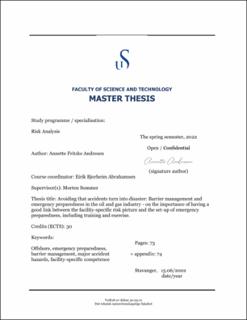| dc.description.abstract | Facility-specific competence is crucial in emergency preparedness organisations on offshore oil and gas facilities to prevent emerging situations from developing into full-blown disasters. However, the Petroleum Safety Authority (PSA) of Norway has, over a more extended period, raised concerns regarding possible decreasing levels of facility-specific competence amongst personnel. The concerns stem from the development in the industry where critical analyses that should be used to identify and include the specific challenges are moved away from the facilities and operators and are rather conducted by external companies. As such, this study investigates the research problem: How to ensure that facility-specific competence is present in an emergency preparedness organisation?
This study approaches the challenge of including facility-specific challenges and measures to handle these in the establishment of emergency preparedness through semi-structured interviews with various companies and the PSA. The interviews uncover that operating and consultant companies often identify facility-specific challenges through the use of qualitative risk analyses and emergency preparedness analyses. Furthermore, the associated roles and competence needed to handle the challenges are identified in the emergency preparedness plans or as part of an organisational barrier element. The interviews also bring forward that the analyses and methodologies used in the industry today, in many cases, are too generic and technical to identify the necessary information needed in the mapping of necessary facility-specific competence.
Building on the theory of emergency preparedness and answers from the interviews, it becomes evident that the analyses and methodologies used in the industry today need to be properly adapted to each facility in order to secure a red line between the generic analyses and the specific conditions at each facility. It is further suggested and emphasised to increase the focus on ‘de-academising’ the information in the QRA, include relevant personnel in the establishment of the emergency preparedness analyses and plans, establish clear and specific competence requirements linked to the various roles, and map the availability of personnel with necessary competence to better secure that personnel with facility-specific competence is present in an emergency preparedness situation. | |
